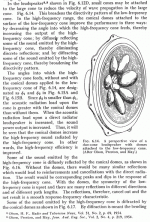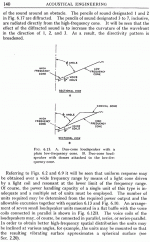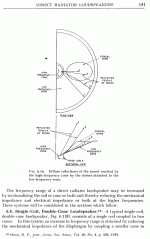An associate recently pulled the 15-inch woofers shown in the attached JPEG out of his closet and asked me if I'm interested in them. (Looking at the pictures, who wouldn't be interested in them?)
He says these were a prototype developed by Victor Japan in 1992 under the guidance of a Dr. Olson. And that's about all he knows about them!
The magnets look a lot like those used by Goto for their deliciously insane bass drivers.
The radiator is a new one on me. I've never seen anything quite like it.
At any rate, if these ring a bell, I'd be very, very grateful for whatever insights anyone might be able to share.
THANKS!
Christopher Witmer
He says these were a prototype developed by Victor Japan in 1992 under the guidance of a Dr. Olson. And that's about all he knows about them!
The magnets look a lot like those used by Goto for their deliciously insane bass drivers.
The radiator is a new one on me. I've never seen anything quite like it.
At any rate, if these ring a bell, I'd be very, very grateful for whatever insights anyone might be able to share.
THANKS!
Christopher Witmer
Attachments
The closest I've seen to these was mag wheels on a car.
It would be interesting to see the design brief on these and what they are supposed to achieve - very weird.
It would be interesting to see the design brief on these and what they are supposed to achieve - very weird.
reply
I've seen those type of speakers before.
A few years I found an electric piano[a very old version] dumped by the side of the road all smashed up,and it had a large panel below the keys which was covered with an ugly brown cloth.
I removed it to find two ugly looking drivers.
When i took them out they had such an old type of magnet system[ a bolt going through the magnet and connection to the centre of the cone with was made of felt and a large metal washer.The cone had the same design brown paper with funny ridges and the magnet looked different though it looked like a bell[probably alnico]
And when the speaker moved in and out the bolt going through the dust cap moved up and down too.
Very strange speakers but crappy wattage though 4 watt for a 12 inch 16 ohm speaker with a paper edge with green felt around the gasket.
I've seen those type of speakers before.
A few years I found an electric piano[a very old version] dumped by the side of the road all smashed up,and it had a large panel below the keys which was covered with an ugly brown cloth.
I removed it to find two ugly looking drivers.
When i took them out they had such an old type of magnet system[ a bolt going through the magnet and connection to the centre of the cone with was made of felt and a large metal washer.The cone had the same design brown paper with funny ridges and the magnet looked different though it looked like a bell[probably alnico]
And when the speaker moved in and out the bolt going through the dust cap moved up and down too.
Very strange speakers but crappy wattage though 4 watt for a 12 inch 16 ohm speaker with a paper edge with green felt around the gasket.
You may be lucky !!!!
or maybe not !!
RCA bought out Victor in about 1920ish??
I doubt whether those are that old, but they are probably not young !! I would be searching through RCA-Victor listings, cos they actually had some top of the range sound gear in their time.
Good luck, you may have a gem !!! perhaps?? 😉
or maybe not !!

RCA bought out Victor in about 1920ish??
I doubt whether those are that old, but they are probably not young !! I would be searching through RCA-Victor listings, cos they actually had some top of the range sound gear in their time.
Good luck, you may have a gem !!! perhaps?? 😉
There's an image of a similar radiator in Olsen's "Acoustical Engineering" with an explanation of the impetus behind the design, if memory serves me correctly.
Just found a pic of it (Duo-cone, Type LC1A) in a paper by Olsen dated October 1954.There's an image of a similar radiator in Olsen's "Acoustical Engineering" with an explanation of the impetus behind the design, if memory serves me correctly.
Good memory.
H.F. Olson is one of the great pioneers in electronics generally. As I recall, he just about invented FM broadcasting. In addition to many other things, he invented the Drone Cone, (which is now called the Passive Radiator).
Former head of the Audio Engineering Society.
Former head of the Audio Engineering Society.
Where can I obtain H. Olson's writings?
Since I am now the (insert adjective here) owner of these prototype speakers, I need to find out as much as possible concerning Dr. Olson's thinking that went into these speakers. Does anyone know where I can obtain copies of his various papers on these speakers and on his research into passive radiators?
By the way, in case it wasn't clear, these differ from the original LC-1 and derivatives in that they are not a coaxial design, but simply a woofer. I learned that Technics (Matsushita) and especially Japan Victor have over the years put out several woofers strongly influenced by this design, but to my knowledge the only coax unit was one produced under license from RCA back in the late 1950s. That was more or less an exact copy but with the nomenclature changed slightly to "LCB1." It might seem strange to produce woofers with these "teats" since part of their function was to broaden and smooth out the dispersion of high frequencies from the tweeter. However, they also have useful functions for the woofer itself.
I'd also be grateful for any tips on how to measure the parameters of these speakers. Until I do that, I won't be able to make much use of them.
Thanks,
Chris Witmer
Since I am now the (insert adjective here) owner of these prototype speakers, I need to find out as much as possible concerning Dr. Olson's thinking that went into these speakers. Does anyone know where I can obtain copies of his various papers on these speakers and on his research into passive radiators?
By the way, in case it wasn't clear, these differ from the original LC-1 and derivatives in that they are not a coaxial design, but simply a woofer. I learned that Technics (Matsushita) and especially Japan Victor have over the years put out several woofers strongly influenced by this design, but to my knowledge the only coax unit was one produced under license from RCA back in the late 1950s. That was more or less an exact copy but with the nomenclature changed slightly to "LCB1." It might seem strange to produce woofers with these "teats" since part of their function was to broaden and smooth out the dispersion of high frequencies from the tweeter. However, they also have useful functions for the woofer itself.
I'd also be grateful for any tips on how to measure the parameters of these speakers. Until I do that, I won't be able to make much use of them.
Thanks,
Chris Witmer
I have "Recent Developments in Direct-Radiator, High-Fidelity Loudspeakers" by Harry F. Olson, John Preston and Everett May. It is in the October 1954 Journal of the Audio Engineering Society, and also in Part 1 of the Loudspeaker Anthology, which is where I got it.
I have a hunch this is the 1954 article you spoke about. In that case, you should already have it. It goes into detail about the development of this loudspeaker, and even how to use a Drone Cone with it.
Thiele-Small parameters were in the future, (actually Novak at Jensen was dealing with them, but I digress). However, Olson does go into a certain size box and the response to be expected from that box. That is a start.
I am guessing you have that article. If you do not, I will Email it to you. I do not OCR articles, I just send it to you page by page, so expect large file sizes.
I have another Olson oarticle on surrounds and suspensions, but I do not think it applies to that speaker. I can send it anyhow. Just let me know your Email address.
I have a hunch this is the 1954 article you spoke about. In that case, you should already have it. It goes into detail about the development of this loudspeaker, and even how to use a Drone Cone with it.
Thiele-Small parameters were in the future, (actually Novak at Jensen was dealing with them, but I digress). However, Olson does go into a certain size box and the response to be expected from that box. That is a start.
I am guessing you have that article. If you do not, I will Email it to you. I do not OCR articles, I just send it to you page by page, so expect large file sizes.
I have another Olson oarticle on surrounds and suspensions, but I do not think it applies to that speaker. I can send it anyhow. Just let me know your Email address.
Initial impressions on these speakers
The only nominally 15-inch woofers I have used in the past were a pair made by Maxonic that were, dimensionally and materially, virtual copies of the Altec 515B. Although these are also nominally 15-inch woofers, these are larger than the 515B, and they weigh slightly more too. The frames are relatively flimsy compared with the 515B, and yet they weigh more: all the weight is in the magnets. The magnets are truly impressive. When I actually use the woofers I'll have to find some way to stiffen the frames and mount them so as to compensate for the relative flimsiness of the frames.
I did the simplest and perhaps least useful of all listening tests: I simply played the raw drivers, with my face as close to the diaphragm as possible. I was very impressed. Even in that state, the bass is quite good and the frequency range surprisingly broad despite being a woofer and not a coax like the original Olson drivers on which it was based.
The sound will no doubt change a lot after the fixed edge has more time to get broken in.
In the meantime, kelticwizard has been more helpful than anyone has a right to expect in providing me with selections from Olson's writings, for which I am deeply grateful.
The only nominally 15-inch woofers I have used in the past were a pair made by Maxonic that were, dimensionally and materially, virtual copies of the Altec 515B. Although these are also nominally 15-inch woofers, these are larger than the 515B, and they weigh slightly more too. The frames are relatively flimsy compared with the 515B, and yet they weigh more: all the weight is in the magnets. The magnets are truly impressive. When I actually use the woofers I'll have to find some way to stiffen the frames and mount them so as to compensate for the relative flimsiness of the frames.
I did the simplest and perhaps least useful of all listening tests: I simply played the raw drivers, with my face as close to the diaphragm as possible. I was very impressed. Even in that state, the bass is quite good and the frequency range surprisingly broad despite being a woofer and not a coax like the original Olson drivers on which it was based.
The sound will no doubt change a lot after the fixed edge has more time to get broken in.
In the meantime, kelticwizard has been more helpful than anyone has a right to expect in providing me with selections from Olson's writings, for which I am deeply grateful.
Love that "butterfly"!
Thanks for the pics. I think this is the first time I ever connected a particular speaker with a particular gender.
-- Chris Witmer
Thanks for the pics. I think this is the first time I ever connected a particular speaker with a particular gender.
-- Chris Witmer
Wow, until I saw daves post, I thought that the lumps on the cones were dips, ie concave. Makes more sense that they are convex!
- Status
- Not open for further replies.
- Home
- Loudspeakers
- Multi-Way
- I need your insights into this mystery woofer



